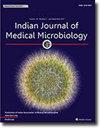Skin colonization by pathogenic bacteria as a risk factor for neonatal sepsis
IF 1.4
4区 医学
Q4 IMMUNOLOGY
引用次数: 0
Abstract
Background
Neonatal sepsis continues to be a leading cause of mortality among the NICU admitted neonates. The most common causative organisms have been proven to be hospital-acquired organisms.
Aims and objectives
This study was planned with aim of understanding the pathological colonization of neonatal skin and associated risk factors as well as finding a possible correlation between blood culture isolates and neonatal skin colonizers and their antimicrobial resistance patterns.
Methods
This prospective cohort study was conducted at a tertiary care centre in Northern India from January 2021 to June 2022. The study participants were 50 pre-term neonates and 50 term neonates, who were born in our hospital and subsequently admitted to the NICU. Skin swabs, taken from 5 body sites within 24 h of birth and at discharge, were cultured for isolation of pathological bacteria. Neonates were followed-up during their hospital stay for observing any occurrence of blood culture positive sepsis.
Results
Out of 100 neonates, 31 pre-term and 28 term neonates were colonized within 24 h of birth while almost all were colonized by discharge. Posterior auricular fossa was the most colonized site. Coagulase Negative Staphylococcus (n = 195) and Escherichia coli (n = 51) were the most common isolates. Risk factors found to be significantly associated with colonization were low birth weight (<2500g), premature rupture of membranes (PROM), invasive mechanical ventilation and positive urine and vaginal cultures of mothers. Neonates with culture positive sepsis also had colonization with MDROs.
Conclusions
Neonatal skin colonization and their antimicrobial resistance rates increased over the course of hospital stay, having a possible contribution towards culture positive sepsis.
致病菌在皮肤上定植是新生儿败血症的危险因素。
背景:新生儿败血症仍然是新生儿重症监护室入院新生儿死亡的主要原因。最常见的致病微生物已被证明是医院获得性微生物。目的和目的:本研究旨在了解新生儿皮肤的病理性定植和相关危险因素,并发现血培养分离物与新生儿皮肤定植菌及其抗菌药物耐药性模式之间的可能相关性。方法:这项前瞻性队列研究于2021年1月至2022年6月在印度北部的一家三级保健中心进行。研究对象为50例早产新生儿和50例足月新生儿,均在我院出生并随后入住新生儿重症监护病房。在出生24小时内和出院时从5个身体部位采集皮肤拭子进行培养,以分离病理细菌。新生儿住院期间随访,观察血培养阳性脓毒症的发生情况。结果:100例新生儿中,31例早产儿和28例足月新生儿在出生24小时内定植,出院时几乎全部定植。耳后窝是蚁群最多的部位。凝固酶阴性葡萄球菌(195例)和大肠杆菌(51例)是最常见的分离株。发现与定植显著相关的危险因素是低出生体重(结论:新生儿皮肤定植及其抗菌素耐药率在住院期间增加,可能有助于培养阳性败血症。
本文章由计算机程序翻译,如有差异,请以英文原文为准。
求助全文
约1分钟内获得全文
求助全文
来源期刊

Indian Journal of Medical Microbiology
IMMUNOLOGY-
CiteScore
2.20
自引率
0.00%
发文量
154
审稿时长
73 days
期刊介绍:
Manuscripts of high standard in the form of original research, multicentric studies, meta analysis, are accepted. Current reports can be submitted as brief communications. Case reports must include review of current literature, clinical details, outcome and follow up. Letters to the editor must be a comment on or pertain to a manuscript already published in the IJMM or in relation to preliminary communication of a larger study.
Review articles, Special Articles or Guest Editorials are accepted on invitation.
 求助内容:
求助内容: 应助结果提醒方式:
应助结果提醒方式:


